Click the above ” Technical Training ” and select “Pin the Official Account“
160,000+ industrial control professionals follow this WeChat platform: technical sharing, learning exchange, industrial control videos
Methods for Mitsubishi PLC to Control Mitsubishi Inverters:
Using the PLC’s digital output to control the inverter (i.e., directly connecting the PLC’s digital output to the inverter’s digital input, allowing the PLC to control the inverter’s start, stop, forward and reverse rotation, and multi-speed operation at high, medium, and low speeds through programming).
Using the PLC’s analog signal to control the inverter.
The PLC controls the inverter using the RS-485 Modbus-RTU communication method.
The PLC controls the inverter using a fieldbus method.
The PLC controls the inverter using RS-485 unprotocol communication method.
Among these, the RS-485 unprotocol communication method for controlling the inverter has been widely used. In the RS-485 unprotocol communication method for controlling the inverter, the PLC is programmed to control via RS serial communication commands.
1. System Composition
The hardware composition of the system includes:
1 FX2N series PLC (product version V3.00 or above);
1 FX2N-485-BD communication board (maximum communication distance 50m) or 1 FXON-485ADP + 1 FX2N-CNV-BD board (maximum communication distance 500m);
Mitsubishi inverters with RS-485 interface (F700 series, S500 series, E500 series, F500 series, A500 series), which can be mixed, but the total number does not exceed 8 units.
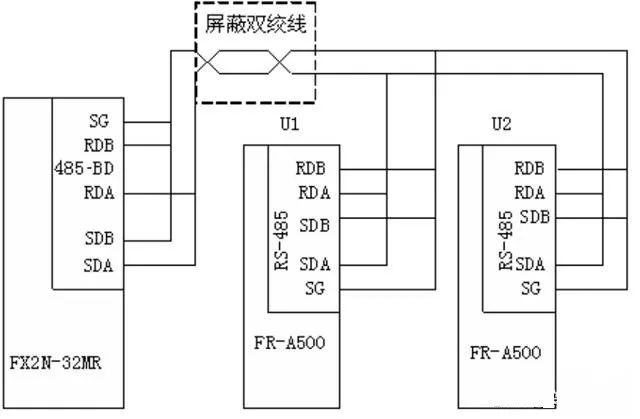
The PLC and inverter are connected using network cables, specifically connecting the RJ45 plug of the network cable to the PU socket of the inverter.
2. Mitsubishi FR-A500 Series Inverter
1. Terminal Wiring Diagram of FR-A500 Inverter

2. Communication Parameter Settings of FR-A500 Inverter
To establish communication correctly, the parameters related to communication must be set on the inverter, such as station number, communication rate, stop bit length/word length, parity, etc.
The parameters Pr.117 to Pr.124 in the inverter are used to set the communication parameters.
Parameter settings can be done using the operation panel or the inverter setup software FR-SW1-SETUP-WE at the PU port.
FR-A500 Communication Parameter Settings
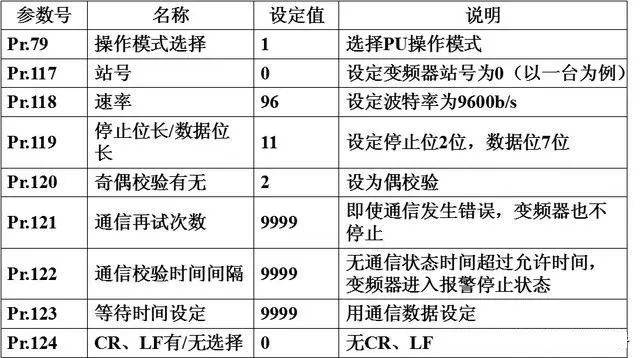
3. Data Format of FR-A500 Inverter
Use hexadecimal numbers, data is automatically transmitted between the PLC and inverter using ASCII code.
1) Communication Request Data Format from PLC to Inverter
If the inverter communication parameter is set to no LF/CR, then the total number of ASCII characters in the communication data sent from the PLC to the inverter is 12 (in format A).

2) Input Data Format from Inverter to PLC

3) Response Data Format from Inverter to PLC When Reading Data
If the inverter communication parameter is set to no LF/CR, then the total number of ASCII characters read from the inverter at one time is 10 (when no errors are found).

4) Sending Data Format from PLC to Inverter When Reading Data

The data in the above formats refers to the data transmitted between the PLC and the inverter (such as frequency and parameters).
The waiting time is the specified time that the inverter waits between receiving data from the PLC and transmitting response data. The waiting time is set based on the PLC’s response time, which is between 0 to 150ms, with a minimum set unit of 10ms. If the parameter Pr.123 is not set to 9999, then the waiting time is not set by the communication data, and there is no waiting time in the communication data format (missing one character).
The checksum is represented by the lowest byte (8 bits) of the total sum of the ASCII data being checked (in binary), expressed as two ASCII digits (hexadecimal).
4) Control Codes and Instruction Codes of FR-A500 Inverter
FR-A500 Control Code Description
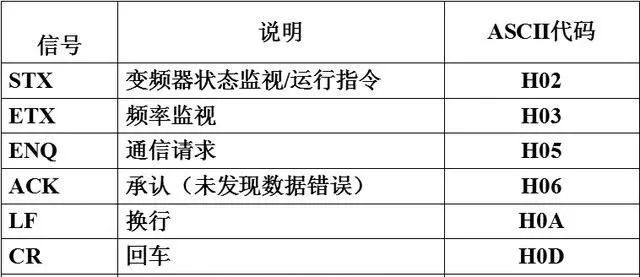
The instruction code is sent from the PLC to the inverter, indicating the program requirements (e.g., run, monitor, etc.). Through the corresponding instruction codes, the inverter can operate and monitor in various ways.
FR-A500 Instruction Code Description
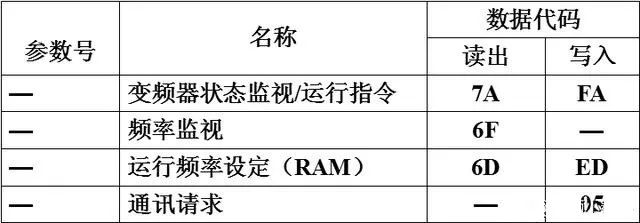
3. Communication Program Design
1. Special Data Registers
(1) D8120 sets the data communication format
Set data length to 7 bits, even parity, 2 stop bits, baud rate of 9600b/s, no header and terminator, no checksum, using unprotocol communication (RS-485). Therefore, the setting of D8120 is: b15~b0=0000 1100 1000 1110=0C8EH.
(2) D8122 stores the bytes in the current sent information that have not yet been sent
(3) D8123 stores the number of bytes received.
(4) D8124 is the start character (8 bits) initial value STX (02H)
(5) D8125 is the end character (8 bits) initial value EXT (03H)
(6) D8129 sets the data network timeout timer value. Its unit is 10ms
2. Communication Program
Set the inverter station number to 0, data length to 7 bits, even parity, 2 stop bits, baud rate of 9600b/s, no header and terminator, no checksum, using unprotocol communication (RS-485).
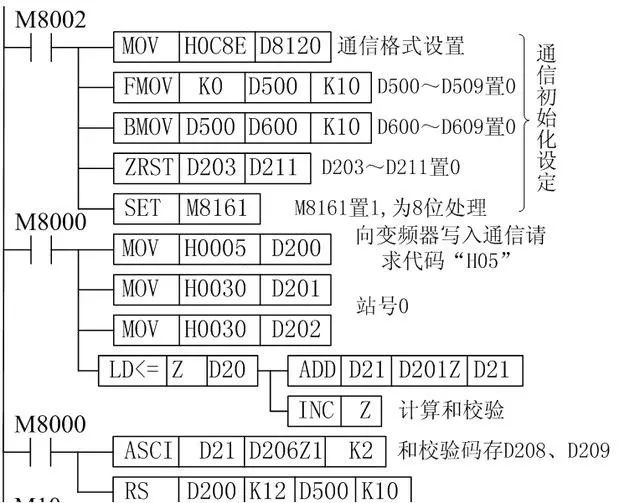
M10 on controls the inverter to enter forward rotation state, M11 on controls the inverter to stop, M12 on controls the inverter to enter reverse state, M13 on reads the inverter’s operating frequency (D700~D703), M14 on writes the operating frequency to the inverter (D400~D403).

When any of M10, M11, M12 is on, the PLC first sends the run control signal to the inverter. D200~D209 are the addresses for sending data, where D200 stores the communication request code 05H, D201, D202 store the inverter station number 0, D203, D204 store the instruction code (run command word FAH), D205 stores the waiting time (0ms), D206~D207 store the sending data (D206, D207 store forward rotation 02H/reverse 04H/stop 00H), D208~D209 store the checksum
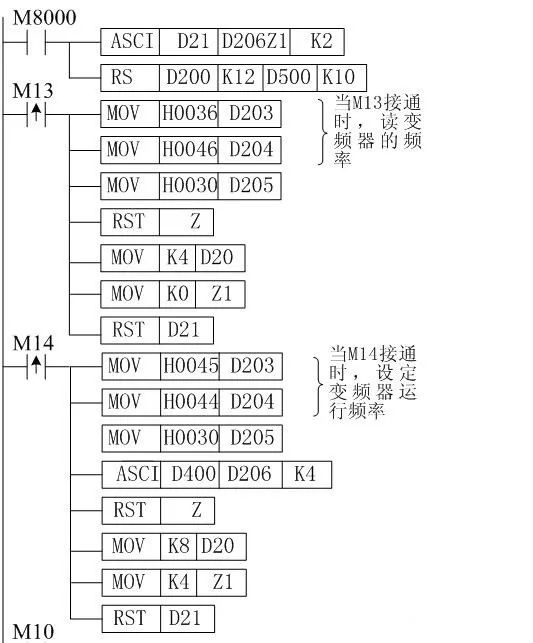
When M14 is on, the PLC sends the operating frequency to the inverter. It is assumed that the operating frequency is stored in D400~D403, D200~D211 are the addresses for sending data, where D200 stores the communication request code 05H, D201, D202 store the inverter station number 0, D203, D204 store the instruction code (write operating frequency command word EDH), D205 stores the waiting time (0ms), D206~D209 store sending data (operating frequency), D210~D211 store the checksum.
When M13 is on, the PLC sends the read control signal for the inverter’s operating frequency. D200~D207 are the addresses for sending data, where D200 stores the communication request code 05H, D201, D202 store the inverter station number 0, D203, D204 store the instruction code (read operating frequency command word 6DH), D205 stores the waiting time (0ms), D206~D207 store the checksum.

D500~D509 are the addresses for receiving data, D600~D609 are the storage addresses for received dataSource: Internet, infringement deletion
Share to Moments, let’s learn together!
ClickRead Original to learn about electrical engineering, PLC, inverter servo, CNC robots, and more.
